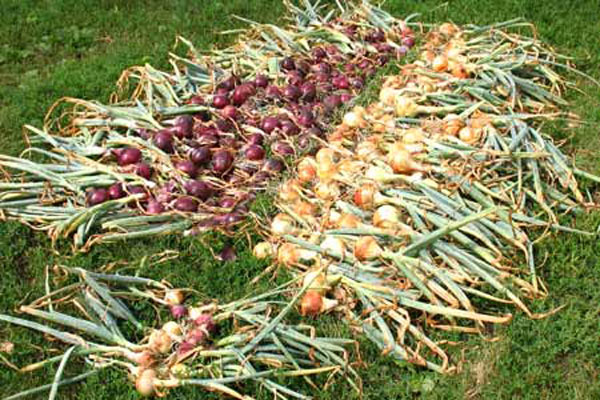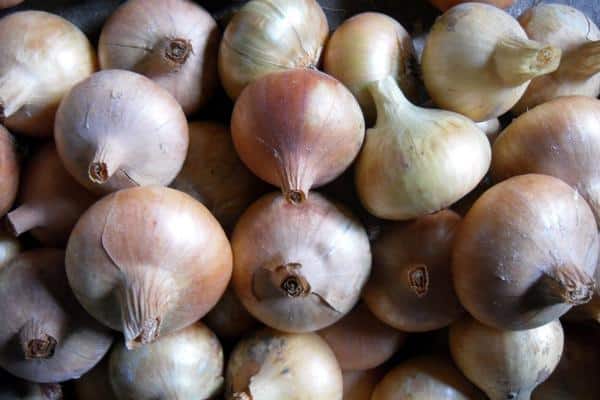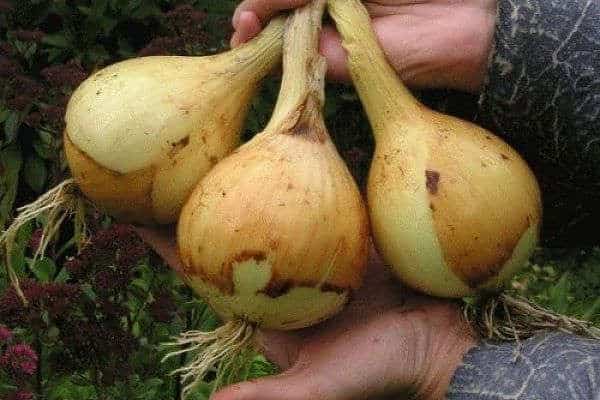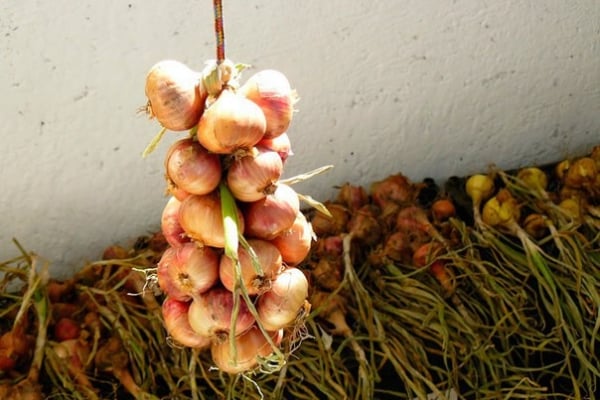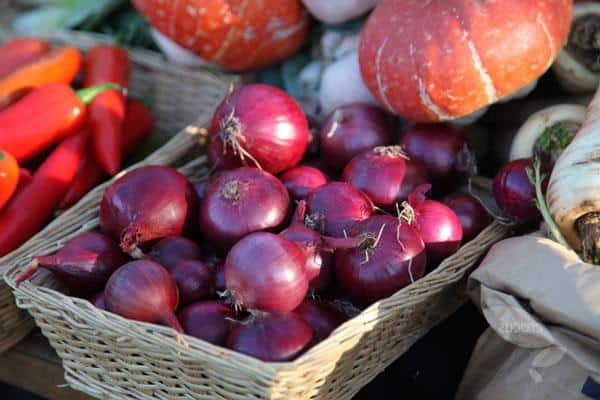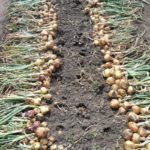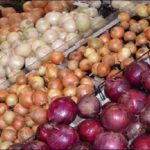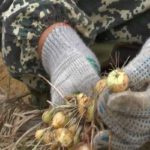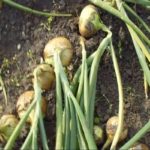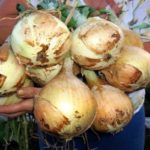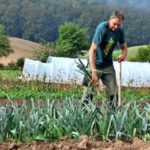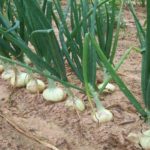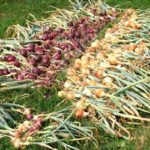Almost all people who have vegetable gardens grow onions. After collecting onion heads from the plot, many people think about how to store onions. To understand the processing of onions for storage, you need to familiarize yourself with the basic nuances of collecting and preparing the harvest for winter.
When to stop watering onions?
Before storing the onion harvest and collecting it from the plot, you need to understand the peculiarities of watering the grown vegetable.Few vegetable growers know that onion heads, which are rarely watered before harvesting, have a high shelf life.
Before harvesting ripe bulbs, it is recommended to gradually reduce the intensity of soil moisture. Determining when to stop watering is quite simple. To do this, carefully examine the leaves of the bushes, which, after gaining mass, line the surface of the ground. Most often, the period of stopping watering occurs 2–2.5 months after planting onions on the site.
If you do not stop further moistening the soil in a timely manner, this will negatively affect the preservation of the crop. Experienced gardeners who know how to preserve onion harvests at home claim that such vegetables are not stored for a long time in winter.
When to remove onions from the garden?
It is imperative to determine the most suitable harvest time. Gardeners often dig up ripe onion heads in the first weeks of August or in the second half of July. However, such dates are not suitable for everyone, since when choosing the exact date, climatic features, weather and the variety of vegetables grown are also taken into account.
To accurately determine onion harvest time, pay attention to the appearance of the plant. Be sure to inspect the upper part of the root crops, which dry out and peel off when fully ripe. You also need to pay attention to the stems of the vegetable. They should be dry and have a yellowish tint. To visually inspect the bulbs, you will have to dig up the plant a little with a pitchfork.
Ripe fruits should be dry and firm.
Some people use simple mathematical calculations to determine when to trim and harvest onions. It is no secret that the average time for full ripening of bulbs is 60–70 days.When determining the harvest date, it is enough to add these numbers to the date of planting the vegetable in the garden. However, when using this method, we must not forget about the peculiarities of weather conditions. For example, due to a dry summer, the harvest is harvested 5–10 days earlier.
Digging and pruning
Having decided on the optimal timing for harvesting and trimming onions, you need to familiarize yourself with the features of this process. However, before this, you should carefully look at the weather forecast for the coming days, since harvesting should only be done in sunny weather. In the absence of rain, the soil will be dry and you will not have to waste time drying the harvested crop.
Digging up the bulbs is quite simple, especially if they are grown in sandy or peaty soil. Most often, difficulties arise when digging up root crops in dense loamy areas. In such cases, pitchforks are used, as they are easier to dig into dense soil.
When digging up the crop with a pitchfork, maintain a distance of 5–10 cm from the bush. The top layer of soil is lifted very carefully so as not to accidentally damage the onion head. Often soil sticks to the dug up fruits, which is better to get rid of. If you do not clear the soil immediately, the bulbs will begin to rot.
After harvesting, when all the onions have been dug up, you can trim the collected fruits. During pruning, root vegetables are carefully cleaned of loose scales and cut off from leaves. In this case, the leaves must be trimmed so that a neck 5–7 cm long remains on the head. The bulbs are also cleared of roots, which are cut with a knife or ordinary scissors under the bottom.
Harvesting onions during the rain
Some people face adverse weather conditions while harvesting onions for storage.In this case, it is better to familiarize yourself with the features of digging up onion heads in rainy weather.
Digging onions in the rain is no different from harvesting in sunny weather. You will also have to dig up the soil with a pitchfork or shovel and carefully remove the root crops from the ground. When the entire crop has been dug up, the tubers are brought into a dry room, where they are cleaned of dirt, husks and roots. The peeled bulbs are laid out on the floor and dried for 7–10 days.
Often, large quantities of onions are dug up from the ground, where there is an increased level of nitrogen. In this case, drying is carried out 2-3 times. This is the only way the harvested crop will be properly stored throughout the winter. It is very important that drying is carried out in a room with a temperature of at least 30 degrees Celsius.
How to dry onions correctly?
Before getting down to the issue of storing onions, you need to become more familiar with the nuances of drying the harvest. The shelf life of the heads depends on the correctness and efficiency of drying.
If the weather is sunny and warm outside in the coming days, then drying can be done directly in the beds. To do this, all root vegetables are laid out in rows and periodically turned over during the week.
When it rains, the onions laid out to dry are covered with a tent or brought indoors. At the same time, they dry better indoors if they are braided. Some people have to dry vegetables in their apartments. For this, heated ovens or gas stoves are used, over which the harvested crop is suspended. When drying in the oven, you need to be very careful not to spoil the vegetables. It is recommended to regularly monitor the oven temperature.Before drying unpeeled onions for storage, they will have to be peeled.
How to store onions?
After collecting, cleaning and drying the green onions, you can begin storing them. To do this, you need to figure out in advance where it is best to store onions in the winter.
In the cellar
People living in the private sector prefer to store onions in the basement for the winter. To do this, they use canvas bags, baskets and even ordinary wooden boxes. If there are no empty containers for storage, root vegetables are simply laid out on racks or shelves.
Some, after the onions are completely prepared for storage, put them in nylon stockings. Any tights or nylon stockings that no one is going to wear are suitable for this. 5–10 onion heads are carefully poured into them, after which the stocking is hung on a hook in the cellar.
To store vegetables, be sure to use nylon products, as this material allows air to pass through well.
In the apartment
Owners of dacha plots often refuse to leave onions at their dacha for the winter and therefore take the harvested crops to their apartments. Storing heads in such rooms is complicated by limited space. Unlike a cellar, you won’t be able to use drawers or racks in living spaces, as they will take up a lot of free space.
Some people braid the harvested crops to save space in their apartments. However, only unpruned plants with leaves are suitable for this. How to store trimmed onions so that they do not sprout? To do this, you can use storage nets.It is recommended to use only nets and not bags, since fabric bags have poor air permeability and therefore the onions quickly become foggy.
In the entrance and on the balcony
Sometimes people do not have free space in their apartment and have to leave all the harvested crops on the balcony or in the entrance. Onion heads should be stored on the balcony in a special thermal box for vegetables. Without such a container, the crop will begin to rot.
Before placing the bulbs in such conditions, you need to figure out at what temperature it is best to store them. All frost-resistant varieties are stored well even at a temperature of 1–2 degrees Celsius. For others, the room temperature should not fall below 15 degrees.
Iterating and saving
To increase the shelf life of harvested onion heads, you need to regularly sort out the crop.
Most often, bulbs are sorted that are in the cellar in winter, since there are the most unsuitable conditions for preserving the harvest. While sorting the bulbs, their appearance is carefully examined. If the head begins to darken, it is immediately disposed of as it begins to rot. It is also recommended to remove vegetables with damaged heads when sorting, as they do not last long.
Conclusion
Vegetable growers who grow onions often face the problem of storing the collected heads. In order for the harvested crop to be stored for a long time, you need to become familiar with the features of harvesting and preserving the bulbs.

